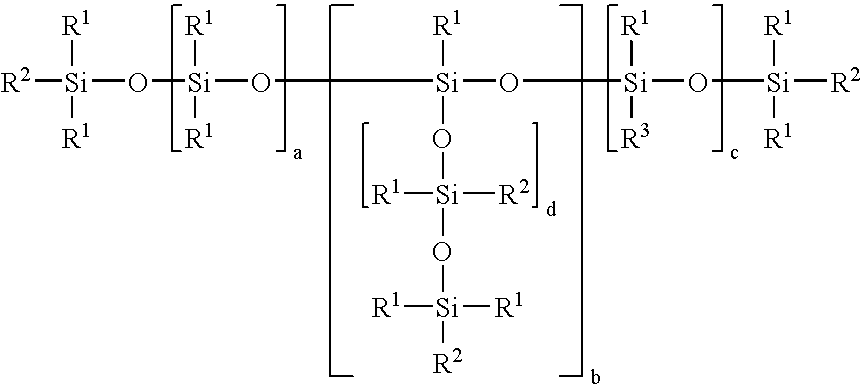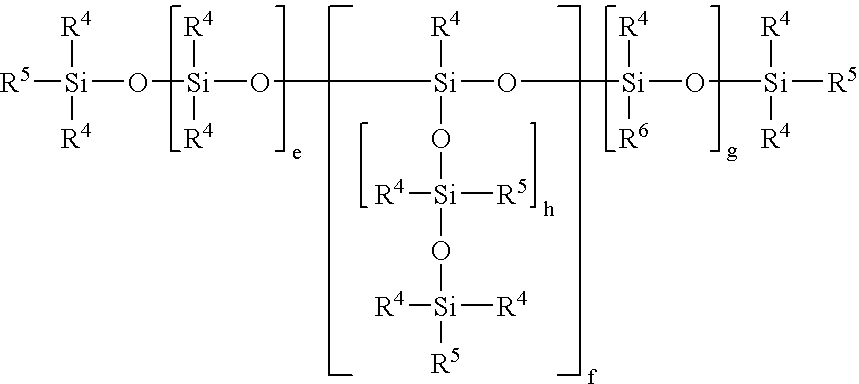POLYSILOXANES CONTAINING (METH)ACRYLIC ESTER GROUPS ATTACHED VIA SiOC GROUPS, PROCESSES FOR PREPARING THEM AND THEIR USE AS A RADIATION-CURABLE ADHESIVE COATING
a technology of acrylic ester and polysiloxanes, which is applied in the field of new polysiloxanes containing (meth) acrylic ester groups attached via sioc groups, can solve the problems of reduced bond strength, high cost, and closure cannot be opened withou
- Summary
- Abstract
- Description
- Claims
- Application Information
AI Technical Summary
Problems solved by technology
Method used
Image
Examples
example 1
[0082] Reaction of a terminal Si—H-functional siloxane (e=7.2, R5=H) with 2-hydroxyethyl methacrylate (HEMA) using a boron catalyst:
[0083] 43.3 g of 2-hydroxyethyl methacrylate were heated to 90° C. in an inert atmosphere in a four-necked flask equipped with stirrer, highly efficient reflex condensor, thermometer and dropping funnel together with 0.043 g of tris(pentafluorophenyl)borane catalyst, 500 ppm of methylhydroquinone, 500 ppm of phenothiazine and 77.3 g of toluene. When the temperature was reached 111.3 g of terminally Si—H-functionalized polydimethylsiloxane (e=7.2, R5=H) of the general formula HMe2SiO(SiMe2O)7.2SiMe2H were added dropwise over the course of 20 minutes. When addition was at an end, and after cooling, the conversion according to the SiH value method was 100%. Distillative removal of the volatile compounds gave a water-clear, colorless liquid which according to 1H and 29Si NMR spectra was assigned the general formula
example 2
[0084] Reaction of a terminal Si—H-functional siloxane (e=7.2, R5═H) with 2-hydroxyethyl acrylate (HEA) using a boron catalyst:
[0085] 46 g of 2-hydroxyethyl acrylate were heated to 90° C. in an inert atmosphere in a four-necked flask equipped with stirrer, highly efficient reflex condensor, thermometer and dropping funnel together with 0.051 g of tris(pentafluorophenyl)borane catalyst, 500 ppm of methylhydroquinone, 500 ppm of phenothiazine and 179.5 g of toluene. When the temperature was reached 133.4 g of terminally Si—H-functionalized polydimethylsiloxane (e=7.2, R5=H) of the general formula HMe2SiO(SiMe2O)7.2SiMe2H were added dropwise over the course of 15 minutes. When addition was at an end, and after cooling, the conversion according to the SiH value method was 100%.
[0086] Distillative removal of the volatile compounds gave a water-clear, colorless liquid which according to 1H and 29Si NMR spectra was assigned the general formula
example 3
[0087] Reaction of a terminal Si—H-functional siloxane (e=7.2, R5=H) with 2-hydroxypropyl acrylate (HPA) using a boron catalyst:
[0088] 27.3 g of 2-hydroxypropyl acrylate were heated to 90° C. in an inert atmosphere in a four-necked flask equipped with stirrer, highly efficient reflex condensor, thermometer and dropping funnel together with 0.039 g of tris(pentafluorophenyl)borane catalyst, 300 ppm of methylhydroquinone and 47 g of toluene. When the temperature was reached 66.75 g of terminally Si—H-functionalized polydimethylsiloxane (e=7.2, R5=H) of the general formula HMe2SiO(SiMe2O)7.2SiMe2H were added dropwise over the course of 15 minutes. When addition was at an end, and after cooling, the conversion according to the SiH value method was 100%.
[0089] Distillative removal of the volatile compounds gave a water-clear, colorless liquid.
PUM
| Property | Measurement | Unit |
|---|---|---|
| Fraction | aaaaa | aaaaa |
| Fraction | aaaaa | aaaaa |
| Fraction | aaaaa | aaaaa |
Abstract
Description
Claims
Application Information
 Login to View More
Login to View More - R&D
- Intellectual Property
- Life Sciences
- Materials
- Tech Scout
- Unparalleled Data Quality
- Higher Quality Content
- 60% Fewer Hallucinations
Browse by: Latest US Patents, China's latest patents, Technical Efficacy Thesaurus, Application Domain, Technology Topic, Popular Technical Reports.
© 2025 PatSnap. All rights reserved.Legal|Privacy policy|Modern Slavery Act Transparency Statement|Sitemap|About US| Contact US: help@patsnap.com



